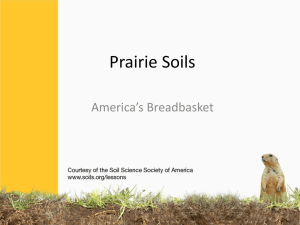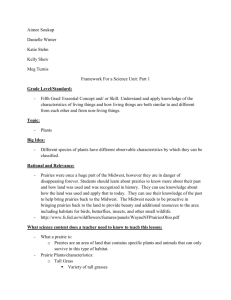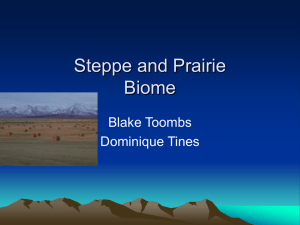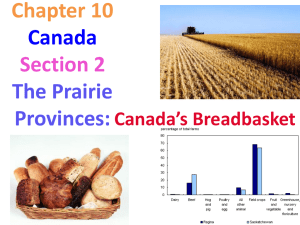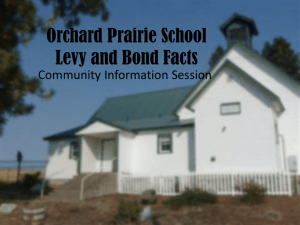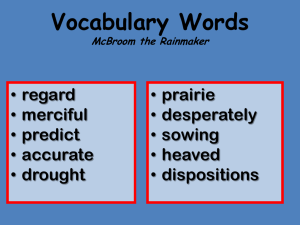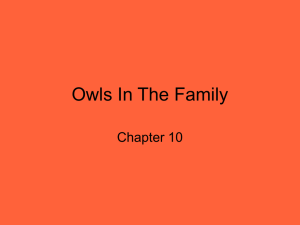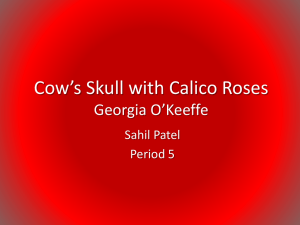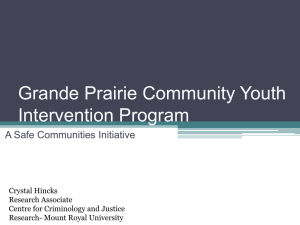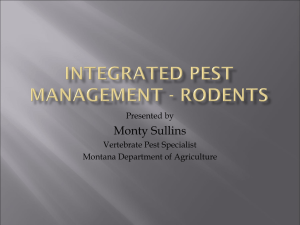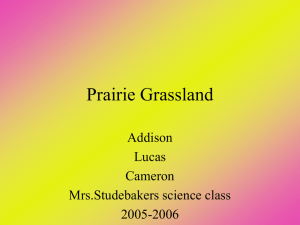Restoration techniques, & commonly found Prairie Plants
advertisement
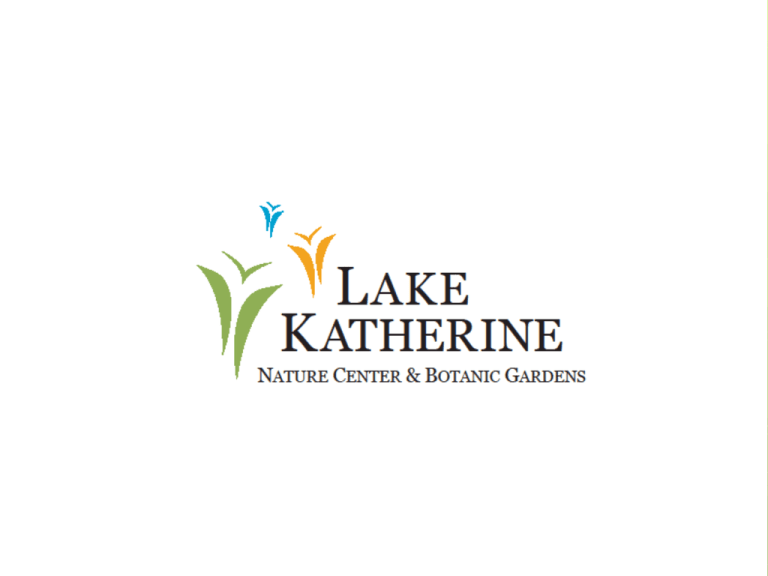
Restoration Techniques, & Commonly Found Prairie Plants Lake Katherine Nature Center & Botanic Garden Introduction Midwestern Ecosystems Invasive Species Control Techniques Commonly Found Prairie Species Rare Prairie Species Perspective Restoration Reconstruction Rehabilitation Tallgrass Prairie-intermixed with Savanna and Woodland. 10,000 years in the making Through fire both natural and lit Modern threats Midwestern Ecosystems Tallgrass Prairie (less than1% left in Illinois) Oak Savanna Oak Woodland Forest Wetlands The prairie forest continuum Wetland and upland part of this continuum Tall Grass Prairie Dominant Big Bluestem Switch Grass Indian Grass Dominant Forbs Compass Plant Prairie Dock Cone Flowers Fire Grasses Dependency Essential to keeping the prairies open Oak Savanna Prairie Wood Interface Bur Oaks the dominant tree Fire Dependent Canopy level approx 10% Oak Woodland Canopy cover between 30% and 50% More shade tolerant species Presence of fire in open woodlands prevents ashes and sugar maples taking over Forest Traditionally located where fires are restricted along river edges and moraines More maple dominant then oak dominant Fires are more rare Forests traditionally somewhat rare in the native landscape of Illinois Encroachment of the Eastern Forests Forest canopy cover typically 80% plus Wetlands Marsh Sedge Meadow Wet Prairie Bog Fen Flat wood Most are fire dependent Invasive Species What is an invasive species? Invasive Species “non indigenous species or strains that become established in natural plant communities and wild areas and replace native vegetation.” Wisconsin The Invasive Plant Association of Teasel Dipsacus spp •Two species •Common (Purple flowered) •Cut Leaved (White Flowers) •Biennial •Introduced for combing wool •Grows as basal rosette for one year •Flowers, produces seed and dies •Seed can remain viable for several years Reed Canary Grass (Phalaris arundinacea) •Planted for forage and erosion control since 1800s •Can invade most types of wetlands •Seeds germinate immediately at maturation •Spread by seed and rhizomes Buckthorn (Rhamnus cathartica, frangula) Oval leaves Orange bark •Very prolific •Seed spread via birds •Shades out understory •Forms monocultures Thorn and the buck Purple Loosestrife (Lythrum salicaria) •Planted originally as a n ornamental •Forms dense stand in wetland areas •Chokes out waterways •Crowds out natives •No natural predators •80,000 stalks per acre have been recorded Honeysuckle (Lonicera spp) Flowering Winter Bark •Four species of honeysuckle excluding hybrids •Shade out understory •Readily spread by birds eating berries •Cut stump will resprout Garlic Mustard (Allaria petiolata) Rosette colonies Maturing plant Introduced by early settlers for use in cooking and medicine Biennial spreads into disturbed area and high quality areas Restoration Techniques Burn Notice Fires are the dominant driving force behind the prairie /savanna/woodland complex Fire Suppression is a key factor in degradation of local ecosystems Fires help control invasive plant species 10,000 years of burns have created some of the rarest habitats seen in the world today Physical Control Removal Cutting Sawing Dragging Raking Chemical Control Essential where fire is suppressed and beneficial where fire is used. Selective Non selective Glyphosate Roundup Trclopyr Garlon Many others Woody Control Cut stump treatment 20% glyphosate soln (water mix) 12.5% triclopyr soln (basal bark oil) Basal bark application 12.5% triclopyr/oil mix Only when bark is still smooth Cutting with saw or axe a ring around the base of the trunk, approx 2” wide, applying herbicide to this area helps. Chemical girdling Girdling Brush piles When the ground is frozen or with snow on the ground Chainsaw/Brush Cutter/Bush Hog Non Woody Control Invasive Spot grasses/forbs treatment with 2% glyphosate Common Reed requires handwicking at 50% glyphosate soln Cutting plants before they go to seed Physical removal -essential to remove all root especially those with rhizomes Planting Seeding Over seeding Interseeding Spraying, tilling, seeding Burn then seed Seeds need to touch dirt Plugging Straight into plant matrix Plug hole Management Mow method Burn Method Combined Watering rarely required Spot spray 3 to 5 years for new seedlings to establish Commonly Found Prairie Plants Prairie Grasses Big Bluestem (Andropogon gerardii) Little Bluestem (Schizachyrium scoparium) Prairie Dropseed (Sporobolus heterolepsis) Indian Grass (Sorghastrum nutans) Switch Grass (Panicum virgatum) Prairie Cord Grass (Spartina pectinata) Side Oats Grama (Bouteloua curtipendula) Big Bluestem (Andropogon gerardii) •Also known as turkey Foot •Quintessential prairie plant •Dry to wet sites •Dominant in mesic sites •Used by Native American to treat digestive problems Little Bluestem (Schizachyrium scoparium) •Characteristic plant of the tall grass prairie •Reaches 4’ tall •Small •Found predominantly mesic sites but also drier sites Prairie Dropseed (Sporobulus heterolepsis) •Characteristic of mesic prairies •Characterized by dense tufts of long, very narrow leaves which are rolled slightly •Flower heads have pungent waxy aroma Indian Grass (Sorghastrum nutans) •Flowering at 7’ tall •Occurs as dense tufts or single stands •Rapid colonizer •Common throughout the tallgrass region Switch Grass (Panicum virgatum) •Common through out the tall grass region •Found in wet to mesic and drier sites •Can become very dominant Prairie Cord Grass (Spartina pectinata) •Very sharp edges leaves •Sometimes called ripgut •Has been used for thatching and fuel Side Oats Grama (Bouteloua curtipendula) •Very distinctive •Low grass 3’ •Flower clusters form in rows along one side of the upper stem •Prefers well drained prairies Canada Wild Rye (Elymus canadensis) •Common along prairie edges •3-5’ tall •Moist to mesic sites •Seeds were used as food by Native Americans Prairie Forbs Compass Plant (Siphium lacinatum) Praire Dock (Silphium terebinthinaceum) Asters (Asteraceae) Boneset (Eupatorium spp) Coneflowers (Echinacea spp) Blazing Stars (Liatris spp) Goldenrods (Solidago spp) Coreopsis (Coreopsis spp) Milkweeds (Asclepsis spp) Vervain (Verbena spp) Bergamot (Monarda fistulosa) Rattlesnake Master (Eryngium yuccifolium) Prairie Dogbane (Apocynum cannabinum) Compass Plant (Silphium laciniatum) •Striking member of the silphium group •Flower very similar to prairie dock •Leaves main distinguishing characteristic •Named for the way it follows the sun •Dried sap was used as chewing gum Prairie Dock (Siphium terebinthinaceum) •Fowers very similar to compass plant •Leaves wide and rough •Also orient themselves towards the sun New England Aster (Aster novae-angliae) •Commonly grown •Has some weedy tendencies •Wet to mesic prairies Tall Boneset (Eupatorium altissimum) •Common in dry upland prairies •More common in areas with history of disturbance Coneflowers (Echinacea spp) Pale Purple Coneflower (Echinacea pallida) •Roots sometimes used for herbal medicines •Ilegal rooting is a threat Purple Coneflower (Echinacea purpurea) •Often used as an ornamental •Blooms from spring to fall Blazing Stars (Liatris spp) •Six commonly found species of liatris •Prairie •Marsh •Dotted •Cylindrical •Rough •Scaly •Dotted blazing star underparts was used as a food of last resort for native americans Prairie Blazing Star (Liatris pycnostachya) Goldenrods (Solidago spp) Early (Solidago juncea) Showy (Solidago speciosa) Coreopsis (Coreopsis spp) Sand Coreopsis (Coreopsis lanceolata) •4 common species •Large flowered •Sand •Prairie •Tall •Prefers drier prairies •Upland sites Milkweeds (Asclepsis spp) •Known for attracting butterflies •Roots of tuberosa have been used as foods by Native Americans •Approx 14 commonly found species found on the prairie •Regular milkweed host plant for monarchs Butterfly Milkweed (Asclepias tuberosa) Bergamot (Monarda fistulosa) •Member of the mint family •Fairly common species though out the tall grass region •Also known as beebalm Rattlesnake Master (Eryngium yuccifolium) •Striking plant a member of the parsley family •Plant leaves resemble yucca leaves •Fairly common among prairies Prairie Dogbane (Apocynum cannabinum) •Common throughout the tallgrass region •Native Americans used the fiber for ropes and nets Restoration Resources The tallgrass restoration handbook Chicago Wilderness Atlas of Biodiversity The prairie of the Illinois country A natural history of the Chicago region
